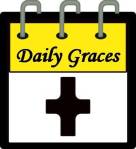While our Gospel passage doesn’t include the specific phrase of Jesus’, “I am the Good Shepherd,” I decided to run with it anyway. It is the immediate next verse following the Gospel for this Sunday and it is so much more than a nice pastoral picture. If Jesus is the Good Shepherd, then we are His sheep. And, unless you have had experience with sheep in a field, it might be surprising that this isn’t the most flattering of descriptions.
Sheep just aren’t smart. They don’t seek out quality food, they eat whatever is under their noses, even if it’s the roots of the plants they ate yesterday. If they fall or roll over onto their back they can’t get back up. Literally, if they end up on their backs with all 4 feet in the air the gases in their stomach will redistribute and they will die within 24 hours. If they are threatened by a predator, they have no defensive capabilities except to attempt to run away.
While sheep aren’t smart, they aren’t without good qualities (thank goodness!). Some of these qualities are highlighted in the Gospel today. Sheep know the voice of their shepherd. They are very good at distinguishing between their shepherd and a stranger. Perhaps even more importantly, they won’t willingly follow a stranger. Sheep are very obedient, provided they are in the shepherd’s presence. They will go wherever he leads them, even if it is somewhere they wouldn’t normally travel along that path in their own ramblings.
Sheep, as you can see, are not able to take care of themselves very well. They need a shepherd. We, when left to our own devices, are often not all that great at taking care of ourselves either. We need a shepherd. Jesus knew this about us which is why He calls Himself the Good Shepherd.
Jesus isn’t just any shepherd. That adjective “Good” is important. He is the Good Shepherd because, as He says:
I am the good shepherd. A good shepherd lays down his life for the sheep.
John 10:11
No one expects an ordinary shepherd to sacrifice his very life for his sheep. The sheep can’t defend themselves, so whatever killed the shepherd would surely take the rest of the flock as well. Not so with Jesus. By laying down His life for us, He protects the whole flock, removing forever the threat of death which terrorized us. Jesus isn’t any old shepherd, He is the Good Shepherd.
This isn’t just a description, this is part of Jesus’ identity and therefore God’s identity. Jesus says: “I am the Good Shepherd.”
I am.
When Moses asked God who was sending him to the Israelites, God said, “God replied to Moses: I am who I am. Then he added: This is what you will tell the Israelites: I AM has sent me to you” (Exodus 3:14). The name of God we are able to perceive, I AM. We know Jesus is God, and we know Jesus was a good Jew. He doesn’t use this phrase lightly. Jesus is revealing to us something intimate about who He is as God. This isn’t the only time Jesus uses this specific phrase in the Gospel of John. In fact, there are 7 which have a description that follows.
I am the Bread of Life
I am the Light of the World
I am the Gate of the Sheep
I am the Good Shepherd
I am the Resurrection and the Life
I am the Way and the Truth and the Life
I am the True Vine
We don’t have time to go into each of these at present, perhaps someday each in turn. There are also a few places where Jesus simply states: I AM. One example is when He stands before the soldiers in the Garden. Jesus says, “I am” when they ask if He is Jesus of Nazareth. At the sound of this phrase, they all fall to the ground. “I am” is no ordinary phrase when spoken by Jesus in John’s Gospel and we would do well to pay attention when He uses it.
Though Jesus is human, He is God. We will never fully comprehend Him. I think that is one of the reasons why He used so many of these “I AM” statements. He is revealing more of Himself to us using metaphors we are able to grasp, even if only a little.
There are many, many titles for Jesus. King of Kings, Lord of Lords, the Door, Redeemer, Savior, Friend, Brother, the Good Shepherd. In the appendix of my Walking With Purpose Bible Study book from this year there was included the Litany of Praise. If you haven’t heard of it before, I highly encourage you to take some time (you will need some time, it’s long but it’s so good) to pray it. If you are able, this litany in adoration is powerful.
I’ll include a portion here, but do click on the link for the full litany.
I praise You,Lord Jesus! You are the Christ.
https://prayerhour.wordpress.com/about/litany-of-praise/
I praise You,Lord Jesus! You are Christ, the King.
I praise You,Lord Jesus! You are the Lamb of God.
I praise You,Lord Jesus! You are the Lion of Judah.
I praise You,Lord Jesus! You are the Bright Morning Star.
I praise You,Lord Jesus! You are our Champion and Shield.
I praise You,Lord Jesus! you are our Strength and our Song.
I praise You,Lord Jesus! you are our Way of our life.
















